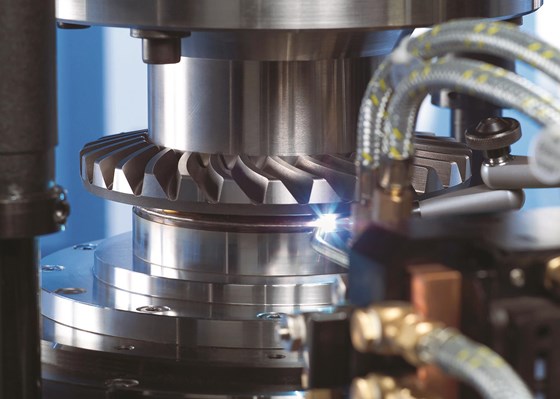
Laser welding can be advantageous in many applications, such as welding differential housings. The welds are strong, and it is possible to eliminate weight in the application—in this case, as many as three pounds if laser welding is used in place of threaded connections.
According to EMAG Corp., replacing the classic screw connection between a ring gear and differential housing with laser welding is a no-brainer given the reduced weight—of course, this requires a high-volume automated system to do it.  So they’ve developed the ELC 250 DUO, a two-station machine that can handle applications like this. The ELC 250 DUO machine design features the EMAG principle of self-loading pickup spindles that, together with separate working stations, means loading and unloading take place while laser processing is occurring, optimizing cycle time. The workpiece moves; the laser lenses are fixed, making part setup and machine programming more straightforward and ensuring all laser processing remains within the machine’s work area.
Moreover, the machine consolidates a number of welding process functions. The pickup spindle can deposit shafts or housings into an integrated four-column mating press, where mating and pressure clamping the gear and housing happen in one operation. An induction heating unit preheats the weld area and the part can be positioned to where the welding is required. Swiveling spindles accommodate radial and axial welding on one part or parallel machining of different components. With two independent machining stations that share a single lasing source, beam switching not only contributes to compact machine design, it means different optics are available to suit differing part requirements. With a nod to sustainability, solid-state lasers contribute to low energy-consumption levels. The stationary machining optic also contributes to more accurate and efficient fume extraction, increasing process efficiency and safety.
The weight savings for a welded differential in a car engine is between one and three pounds, the company says, a clear cost savings on its own, with the added process benefits of eliminating the machining and assembly of high-strength threaded connections. There are geometry benefits, too. Flanges on laser-welded differential cases can be smaller, and the higher-quality welds and reduced heat stresses can contribute to lower ring gear deformation, meaning quieter operation.
Not that laser welding is challenge-free. Ring gears are made of case-hardened steel while differential housings are likely castings. Die-cast aluminum, while strength-specific to many automotive components, is prone to blowouts and leaks at the weld seam. Welding cast material, therefore, is always a critical process and it is essential it be tailored to the specific component. There are no off-the-rack solutions, EMAG says.
Another aspect of setting up a laser-welding process is having clean parts. Oils, coolants, pastes, phosphating, etc., can pollute the laser-welding process. Making sure the welding zone and that each part comes to the process clean is essential. The ELC 250 DUO can also handle component cleaning with laser ablation for weld prep, says Dr. Andreas Mootz, CEO of EMAG Automation. There is far less process maintenance compared to cleaning stations using liquids. Laser ablation removes all typical organic contamination on the weld surface, and process efficiency improves by virtually eliminating idle time between laser cleaning and laser welding. Â Â








